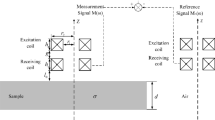Abstract
The shielding effect caused by the cladding has a serious influence on pulsed eddy current testing (PECT) of ferromagnetic metallic structures. To analyze the shielding effect and reveal the essence for reducing the shielding effect, a non-coaxial transmitter–receiver sensor (TR sensor) is used, and the influence of the shielding effect caused by the cladding on the TR sensor is studied theoretically in this paper. Firstly, an analytical model for the TR sensor with rectangular cross-section coils is conducted by using the first integral mean value theorem. Then, on the basis of the analytical model, the expression of the shielding effectiveness is derived to quantitatively evaluate the shielding effect and the spatial frequency spectra is utilized to research the characteristics of the sensor. Based on these, the performances of the TR sensor for reducing the shielding effect are studied. Results show the TR sensor which is more sensitive to the smaller radial spatial frequency can be used to reduce the shielding effect caused by the galvanized steel sheet.















Similar content being viewed by others
References
Chen, Z., Yusa, N., Miya, K.: Some advances in numerical analysis techniques for quantitative electromagnetic nondestructive evaluation. Nondestruct. Test Eval. 24, 69–102 (2009). https://doi.org/10.1080/10589750802195501
Xie, S., Chen, Z., Chen, H., Wang, X., Takagi, T., Uchimoto, T.: Sizing of wall thinning defects using pulsed eddy current testing signals based on a hybrid inverse analysis method. IEEE Trans. Magn. 49, 1653–1656 (2013). https://doi.org/10.1109/TMAG.2012.2236827
Fan, M., Cao, B., Sunny, A.I., Li, W., Tian, G., Ye, B.: Pulsed eddy current thickness measurement using phase features immune to liftoff effect. NDT E Int. 86, 123–131 (2017). https://doi.org/10.1016/j.ndteint.2016.12.003
Li, Y., Tian, G.Y., Simm, A.: Fast analytical modelling for pulsed eddy current evaluation. NDT E Int. 41, 477–483 (2008). https://doi.org/10.1016/j.ndteint.2008.02.001
Demers-Carpentier, V., Rochette, M., Hardy, F., Grenier, M., Tremblay, C., Sisto, M., Potvin, A.: Pulsed Eddy Currents: Improvements in Overcoming Adverse Effects of Galvanized Steel Weather Jacket. 15th Asia Pacific Conference for Non-Destructive Testing (APCNDT2017) (2017)
Cheng, W.: Pulsed eddy current testing of carbon steel pipes’ wall-thickness through insulation and cladding. J. Nondestruct. Eval. 31, 215–224 (2012). https://doi.org/10.1007/s10921-012-0137-9
Xu, Z., Wu, X., Huang, C., Kang, Y.: Measurement of wall thinning through insulation with ferromagnetic cladding using pulsed eddy current testing. Adv. Mater. Res. 301, 426–429 (2011). https://doi.org/10.4028/www.scientific.net/AMR.301-3.426
Mook, G., Hesse, O., Uchanin, V.: Deep penetrating eddy currents and probes. Mater. Test 49, 258–264 (2007). https://doi.org/10.3139/120.100810
Kojima, F., Takagi, T., Matsui, T.: Inverse methodology for eddy current testing using transmitter-receiver coil probes. Rev. Prog. Quant. Non-destruct. Eval. 23A, 643–650 (2004). https://doi.org/10.1063/1.1711682
Rosell, A.: Efficient finite element modelling of eddy current probability of detection with transmitter-receiver sensors. NDT E Int. 75, 48–56 (2015). https://doi.org/10.1016/j.ndteint.2015.07.001
Xie, S., Chen, Z., Takagi, T., Uchimoto, T.: Quantitative non-destructive evaluation of wall thinning defect in double-layer pipe of nuclear power plants using pulsed ECT method. NDT E Int. 75, 87–95 (2015). https://doi.org/10.1016/j.ndteint.2015.06.002
Rybachuk, V.G., Kulynych, Y.P.: Signals from an attachable anaxial-type eddy-current transducer positioned above a conducting half-space. Russ. J. Nondestruct. Test 50, 350–358 (2014). https://doi.org/10.1134/S1061830914060084
Yin, W., Binns, R., Dickinson, S.J., Davis, C., Peyton, A.J.: Analysis of the liftoff effect of phase spectra for eddy current sensors. IEEE Trans. Instrum. Meas. 56, 2775–2781 (2007). https://doi.org/10.1109/TIM.2007.908273
Cao, B., Li, C., Fan, M., Ye, B., Gao, S.: Analytical modelling of eddy current response from driver pick-up coils on multi-layered conducting plates. Insight 60, 77–83 (2018)
Thomas, G.B., Finney, R.L., Weir, M.D., Giordano, F.R.: Thomas’ Calculus. Addison-Wesley, Reading (2003)
Dodd, C.V., Deeds, W.E.: Analytical solutions to eddy-current probe-coil problems. J. Appl. Phys. 39, 2829–2838 (1968). https://doi.org/10.1063/1.1656680
de Haan, V.O., de Jong, P.A.: Analytical expressions for transient induction voltage in a receiving coil due to a coaxial transmitting coil over a conducting plate. IEEE Trans. Magn. 40, 371–378 (2004). https://doi.org/10.1109/TMAG.2004.824100
Fan, M., Huang, P., Ye, B., Hou, D., Zhang, G., Zhou, Z.: Analytical modeling for transient probe response in pulsed eddy current testing. NDT E Int. 42, 376–383 (2009). https://doi.org/10.1016/j.ndteint.2009.01.005
Chew, W.C.: Waves and Fields in Inhomogeneous Media. IEEE Press, New York (1990)
Theodoulidis, T., Kriezis, E.: Series expansions in eddy current nondestructive evaluation models. J. Mater. Process. Technol. 161, 343–347 (2005). https://doi.org/10.1016/j.jmatprotec.2004.07.048
Paul, C.R.: Introduction to Electromagnetic Compatibility, 2nd edn. Wiley, New Jersey (2006)
Harrison, D.J.: Characterisation of cylindrical eddy-current probes in terms of their spatial frequency spectra. IEEE Proc.: Sci. Meas. Technol. 148, 183–186 (2001). https://doi.org/10.1049/ipsmt:20010461
Acknowledgements
This research was supported by the National Key Research and Development Program of China [Grant No. 2017YFF0209701].
Author information
Authors and Affiliations
Corresponding author
Additional information
Publisher's Note
Springer Nature remains neutral with regard to jurisdictional claims in published maps and institutional affiliations.
Rights and permissions
About this article
Cite this article
Zhang, Q., Wu, X. Study on the Shielding Effect of Claddings with Transmitter–Receiver Sensor in Pulsed Eddy Current Testing. J Nondestruct Eval 38, 99 (2019). https://doi.org/10.1007/s10921-019-0638-x
Received:
Accepted:
Published:
DOI: https://doi.org/10.1007/s10921-019-0638-x




